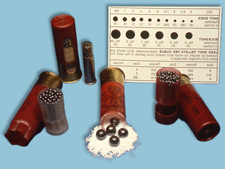- 01: Introduction
- 02: History
- 03: Propellants, Firearms, and Ammunition Development
- 04: Modern Firearms Manufacture
- 05: Small Arms Ammunition
- 06: Evidence Handling Procedures
- 07: Equipment and Instrumentation
- 08: Examination of Firearms
- 09: Cartridge and Shotshell Examination
- 10: Characterization and Evaluation of Fired Projectiles
- 11: Bullet Comparison and Identification
- 12: Gunshot Residue and Distance Determination
- 13: Toolmark Identification
- 14: Communicating Results
- Resources


Current Manufacture
Home > Small Arms Ammunition > Projectiles > Current Manufacture
The current technique for manufacturing shot pellets is accomplished with the Bliemeister method. This method eliminates the need for a shot tower.
The steps to produce round pellets are:
- Molten lead passes through successive screens that are repeatedly agitated.
- Lead droplets fall less than one inch into hot water (as opposed to a ten-story drop).
- The near-spherical pellets roll down an incline and are sorted by shape.
- The nonrounded, rejected shapes are recycled and remelted.

Shotshell and pellets
In the United States, large shot pellets (buckshot) range in size from .24 caliber (No. 4 Buck) to .36 caliber (000 Buck). Buckshot was once formed as drop shot, but large drops of lead do not form into spheres as readily as small drops and the rejection rate was high.
Today, most buckshot is made from lead wire using the following process:
- A strand of wire is fed between two counter-rotating wheels that meet rim-to-rim.
- Hemispheres are milled into the rim of each wheel.
- Rotation is timed so that the hemispheres in each wheel meet as the wheels turn.
- Round balls are formed where the cavities meet and excess lead is flattened.
- After rolling, the flattened strip is tumbled to remove the excess lead and free the pellets. The tumbling action also improves concentricity of the pellets.
Lead pellets may be plated with copper or nickel before loading. A tough outer coating helps protect the pellets from deformation. This step is reserved for premium-grade ammunition.




